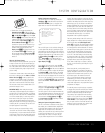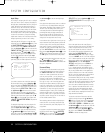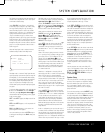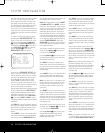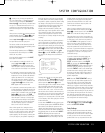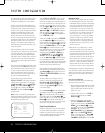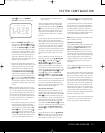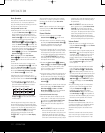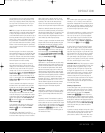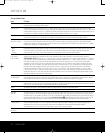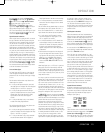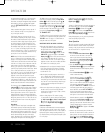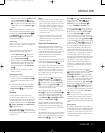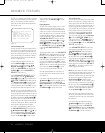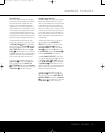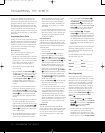
OPERATION
OPERATION 23
grams bearing the logo of one of the major surround-
encoding processes, such as Dolby Surround or DTS
Stereo, may be played in either the Dolby Digital,Dolby
Pro Logic II Cinema,
DTS Neo:6 Cinema, or Logic 7
Cinema surround modes depending on the source
material.
NOTE: Once a program has been encoded with matrix
surround infor
mation, it retains the surround information
as long as the program is broadcast in stereo.Thus,
movies with surround sound may be decoded via any of
the analog surround modes such as Dolby Pro Logic II
Cinema, Logic 7 Cinema or DTS Neo:6 Cinema, when
they are broadcast via conventional TV stations,cable,
pay-TV and satellite transmission. In addition, a growing
number of made-for-television programs, sports broad-
casts, radio dramas and music CDs are also recorded in
surround sound.
Even when a program is not listed as carrying inten-
tional surround information, you may find that the Dolby
Pro Logic II, Logic 7 Enhanced or DTS Neo:6,VMAx
and the Hall or Theater modes often deliver enveloping
surround presentations through the use of the natural
information present in all stereo recordings.
Surround modes may be changed at any time by
using either the front panel or remote control.Any
changes made to the surround mode will be retained
in the AVR’s menu, even after the AVR is placed in
Standby mode.To select a new surround mode from
the front panel, first press the
Surround Mode Group
Selector Button
7 until a mode from the desired
major surround mode group such as Dolby, DTS or
Logic 7 is selected. Next, press the
Surround Mode
Selector Button
8 to choose the specific individual
surround mode
.
T
o select a surround mode using the remote, press
the button for the major surround mode group that
includes the mode you wish to choose from:
Dolby
w, DTS Surround x, DTS Neo:6 ,
Logic
7
y, Stereo or DSP Surround k.
The first press of the button will show the current
mode from that group.To cycle through the available
modes in that group, press the button again until the
desired mode appears in the
Lo
wer Display Line
¯, the on-screen display and in the Surround
Mode Indicators
˘.
As the surround modes change
, the choice will be
displayed in the on-screen display, in the
Lower
Display Line
¯ and in the Surround Mode
Indica
tors
˘.
The Dolby Digital, Dolby Digital EX and DTS 5.1,
DTS-ES Matrix and DTS-ES Discrete modes may only
be selected when a digital input is in use. In addition,
when a digital source is present, the AVR 135 will
automatically select and switch to the correct mode,
regardless of the mode that has been previously
selected.
For more information on selecting digital
sources
, see the Digital Audio Playback section below.
When the 6-channel/8-channel direct inputs are in
use there is no surround processing, as these inputs
take the analog output signals from an optional,
exter-
nal DVD-Audio or SACD player, or another source
device and carry them straight through to the volume
control without any further digital processing.
To listen to a program in traditional two-channel stereo,
using the front left and front right speakers only (plus
the subwoofer, if installed and configured), press the
Stereo Button until SURR OFF appears in the
Lower Display Line ¯, or press the Surround Mode
Group Selector
7 until the Stereo
modes appear in
the on-screen display and
Lower Display Line ¯.
Next, press the
Surround Mode Select Button 8
until SURROUND OFF appears in the on-screen
display and
Lower Display Line ¯.
Digital Audio Playback
Digital audio is a major advancement over older analog
surround processing systems such as Dolby Pro Logic.
It delivers five discrete channels: left front, center,right
front, left surround and right surround. Each channel
reproduces full frequency range (20Hz to 20kHz) and
offers dramatically improved dynamic range and signifi-
cant improvements to signal-to-noise ratios.In addition,
digital systems have the capability to deliver an additional
channel that is specifically devoted to low-frequency
infor
mation.
This is the
“.1”
channel referred to when you
see these systems described as “5.1,”“6.1” or “7.1”.
The bass channel is separate from the other channels,
but since it is intentionally bandwidth-limited,
sound
designers have given it that unique designation.
Dolby Digital
Dolby Digital is a standard part of DVD, and is available
on specially encoded LD discs and satellite broadcasts
and it is a part of the high-definition television (HDTV)
system.
An optional, external RF demodulator is required to
use the AVR 135 to listen to the Dolby Digital sound-
tracks available on laser discs. Connect the RF output
of the LD player to the demodulator and then connect
the digital output of the demodulator to the
Optical or
Coaxial Inputs *(·c of the AVR 135. No
demodulator is required for use with DVD players
or
DTS-encoded laser discs.
DTS
DTS is another digital audio system that is capable of
delivering 5.1 or 6.1 discrete or matrix sound field
reproduction.
Although both DTS and Dolby Digital are
digital,
they use different methods of encoding the sig-
nals, and thus they require different decoding circuits
to convert the digital signals back to analog.
DTS-encoded soundtracks are available on select DVD
and LD discs, as well as on special audio-only DTS
discs.You may use any LD or CD player equipped
with a digital output to play DTS-encoded discs with
the AVR 135.All that is required is to connect the
player’s output to either an
Optical or Coaxial Input
on the rear panel ·c or front panel *(.
In order to listen to DVDs encoded with DTS sound-
tracks, the DVD player must be compatible with the
DTS signal as indicated by a DTS logo on the player’s
front panel. Early DVD players may not be able to play
DTS-encoded DVDs.This does not indicate a problem
with the AVR 135, as some players cannot pass the
DTS signal through to the digital outputs. If you are in
doubt as to the capability of your DVD player to handle
DTS discs, consult the player’s owner’s manual.
IMPORTANT NOTE: Many DVD players have a default
setting that does not pass through the DTS data, even
though the machine is capable of doing so. If your
DVD player has the “DTS Digital Out” logo but does
not trigger DTS playback in the AVR 135, change the
player's settings in the “Audio” or “Bitstream” configu-
ration menu so that DTS playback is enabled.The
method for doing this will vary with each player. In
some cases, the proper menu choice will be “Original,”
while in others it will be “DTS.” Consult the owner's
manual for your player to find the specific infor
mation
to find the proper setting
.
Selecting a Digital Source
To utilize either digital mode, you must have properly
connected a digital source to the AVR 135. Connect
the digital outputs from DVD players
, HDTV receivers,
satellite systems or CD players to the
Optical or
Coaxial Inputs *(·c. In order to provide a
backup signal and a source for analog stereo recording,
the analog outputs provided on digital source equipment
should also be connected to their appropriate inputs on
the AVR 135 rear panel (e.g., connect the analog stereo
audio output from a DVD to the
DVD Audio Inputs h
on the rear panel when you connect the source’s
digital outputs).
If you have not already configured an input for a digital
source using the on-screen menus as shown on page
16, first select the input using the remote or front-
panel controls as outlined in this manual.
Next,
select
(Continued on p. 25)
33
34
35
36
37
38
39
40
41
48
49
46
47
44
45
42
43
38
39
40
41
31
32
30
28
29
25
2
6
27
28
29
30
24
23
22
2
1
20
31
3
7
36
35
34
33
32
31
37
36
35
34
33
32
48
49
50
51
47
46
45
44
43
42
33
34
35
36
37
38
39
40
41
48
49
46
47
44
45
42
43
38
39
40
41
31
32
30
28
29
25
26
27
28
29
30
24
23
22
21
20
31
37
36
35
34
33
32
31
37
36
35
34
33
32
48
49
50
51
47
46
45
44
43
42
33
34
35
36
37
38
39
40
41
48
49
46
47
44
45
42
43
38
39
40
41
31
32
30
28
29
25
26
27
28
29
30
24
23
22
21
20
31
37
36
35
34
33
32
31
37
36
35
34
33
32
48
49
50
51
47
46
45
44
43
42
AVR 135 OM 12/3/04 12:11 PM Page 23



